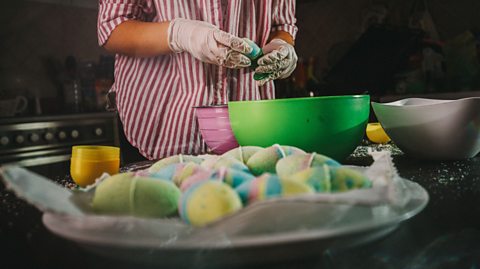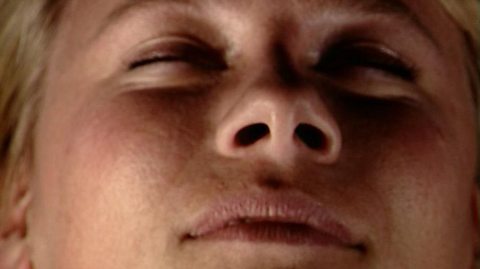You eat well, you sleep well, you exercise. This is fantastic essential self-care.
But being stuck in the same environment, day in, day out, can be pretty draining, and sometimes itтs the little things that make us feel pampered.
Self-care can mean anything from seeking treatment when you're ill to staying clean, fit and healthy - but it's also nice things we can do for ourselves. Candles, chocolate, bubble baths, a good cup of teaтІ all the stuff that makes you go тoohт.
But these are easy to forget when your home has become the new school or office. Treat your household to a homemade spa day or simply have some relaxing me time with these scientific DIY self-care activities.
Please make sure you always test these mixes on a very small skin area first, especially if you have sensitive skin, an allergy or any skin conditions.
Less than 5 minutes: Build-your-own calming scent
Calmness is a state of mind, but itтs difficult to switch it on and off - especially when youтre going through a stressful event. However, smells can affect our mood, and you can create your own calming smell to get you focused on studying or just help you chill out.
You can use 20-30 drops (per 250ml of water) of essential oil if you have it, otherwise you can use old perfume, vanilla essence or even herbs and spices - whatever smell you enjoy and can find in your home! Always test your mix on a small area first to check you don't have a reaction, especially when using essential oils.
To get you started, follow these steps to make your own personalised scent bottle:
How long: A few minutes
How many: One standard size spray bottle
- Mix your scent with 250ml of water. Adjust according to the size of your bottle
- If you want it to double as an air freshener, mix in one and a half tbsp of baking powder (this neutralises odours)
- Pour it into your bottle. You can reuse an old hair oil spray bottle or similar as long as you thoroughly wash it out first
- Thatтs it! Spritz away.
If you donтt have a spray bottle, simply soak a cloth in the mixture (or add 2-3 drops of essential oil directly) and wave it under your nose when youтre about to start your chill time. Your brain will start to associate the smell with being calm and help put you in that state of mind whenever you smell it.
Tip: Make a separate scent for studying so your brain knows which one is for perking up and which one is for winding down. Smells like coffee, orange or lemon can be quite invigorating, while lavender and rosemary are normally associated with relaxation.
Less than 30 minutes: A yummy facemask
Oats, honey, yoghurt - sounds like a perfect breakfastтІ but itтs actually a recipe for a homemade face mask! In fact, there are many pampering wonders to be found right at home in your kitchen. Try this out to freshen you up for the day:
How much: a good dollop per face
How long: 5-10 minutes prep, 20 minutes relaxing
- Boil some water and stir it into the oats to make your porridge - about 30g of oats will do for one person, though you can make more to eat if you like. Allow it to cool before putting it anywhere near your face
- Mix in one tsp of honey and one tsp of yoghurt
- When the mixture has cooled to warm or tepid - NOT hot - apply a generous layer to the face
- Leave for 20 mins and put your feet up
- Wash off with warm water (no need to scrub, but do make sure you get it all off before you scare your household)
- See how refreshed your skin feels!
It might sound a bit unusual to put porridge on your face, but many foods are good for the outside of you as well as the inside. You might have heard of babies with chicken pox being given oat baths to sooth their itch; this is because oats moisturise and sooth the skin, restoring its PH balance.
Oats also contain zinc, which is a natural anti-inflammatory used in many sun care and acne products. Honey is a natural anti-bacterial to help cleanse your face. The lactic acid in the yoghurt also gently exfoliates the top layer of dead skin, leaving it feeling smooth - but oats will work wonderfully by themselves if youтre vegan.
Please be mindful of anything you put on your face if you have sensitive skin, and wash off straight away if you feel notice any redness or stinging!

For about an hour: Fizzy fun
Have you ever wondered what puts the bomb in bath bomb? Letтs break it down and find out. For this recipe, you might have to ask for one or two ingredients in your next essential shop, but you probably have many of them at home already.
How many: four mini bath bombs
How long: 30 mins prep, 45 mins to dry (or more if the weather is very moist)
- Wear washing up gloves to avoid staining your hands. For the dry ingredients, mix together 100g bicarbonate of soda (sometimes known as baking soda), 50g citric acid powder and 25g of cornflour in a bowl.
Citric acid is a weak acid found in citrus fruits - in powdered form it's often used as flavouring. It can be an irritant, though, so be careful, and don't let it come into contact with your eyes.
Alternatively, you can use cream of tartar (about 1 cup for each 2 cups of bicarb). You can add 25g Epsom salt if you want your bath bombs to be cleansing. Do not eat!
- For the wet ingredients, mix two tbsp of sunflower, coconut or olive oil.
- To make your bathbomb smelly, add 1/4 teaspoon of food flavouring (such as vanilla essence) OR 1/4 teaspoon essential oil if you have it - but donтt overdo it!
- You can also add colour food colouring at this step - just make sure that the colouring and the oils are mixed as much as possible
- Pour the wet ingredients into the dry a few drops at a time, whisking the dry ingredients thoroughly between each addition. Itтs important to add the wet stuff slowly, or your bomb will fizz before itтs in the bath
- When the ingredients are combined, scoop out the mixture with a measuring spoon and pat it out on a plate like a sandcastle - you should have a dome that stays together
- Leave to dry for 45 minutes or longer if the weather is wet (moist air slows down the drying of the powdery ingredients). Give them a very light tap to check if theyтve gone hard
- Once dry, gift them to a member of your householdтІ or chuck them in the bath!
The bicarbonate of soda acts as a neutralising substance (base) to the citric acid when water is added, and the reaction releases carbon dioxide bubbles - this is what makes them fizz! The reaction also helps break up the bath bomb, releasing the fragrances and oils.
For an extra special touch you can add bits of flower petals from the garden (ask before you pick) or use a shaped mould rather than a measuring spoon to zhoosh up your bath bombs.

For an afternoon: Change your scene
A simple, effective and underrated method of self-care is to make yourself a nice environment to stay in. After all, it will give you room for all your creative self-care endeavours.
Start small - maybe organise a single drawer, or pick up every sock you can find. Little and often is far better for staying on top of mess than trying to do it all in one go, as youтre more likely to give up. Carving out a specific time for tidying (e.g. 10 minutes every day at 4pm) can also reduce the likelihood of putting it off - think of it as clearing your canvas ready to paint.
Then the fun part: arrange your room the way YOU want to. Add bright scarves, throws or posters in your favourite colour to brighten up your environment. You might find that you want a minimalist corner that is reserved for studying, or a pile of furry cushions to cuddle while you read. Experiment and find what colours, prints and textures make you feel comfortable. You could even pot some plants and refresh your room by adding a bright green space.
There is some truth in the saying тTidy room, tidy mindт, as being surrounded by clutter can increase anxiety and has even been linked to bad sleep. But something as simple as rearranging your room can offer your brain some variety you need to help prevent you feeling blue - so if you find that throws and pillows everywhere helps to lift your mood, go ahead and build yourself a nest.

For a lifetime: Be mindful
When you can exist in the present, it means past and future worries are off the table - at least for five minutes. In an unstable time, mindfulness can be a soothing activity to reduce anxiousness and also get you in a good state of mind to focus. Whether you need to calm down, study or finish that quarantine project, practising a mindfulness exercise each day can help you feel more in control. Here's an example:
How long: Five minutes
Optional: Use your DIY scent spray to give you a new smell to focus on and help you be calm.
- Find a quiet place where you can sit comfortably
- Without thinking too much, count five things you can see, four you can feel (emotionally and physically, such as your DIY face mask!), three things you can hear, two things you can smell and one thing you can taste
- Then close your eyes and be mindful of your breathing
- Have problems concentrating? Thatтs fine!
- Acknowledge any thoughts, sounds, or feelings that make your mind wander, but then pull your focus back to your breath.
Tip: Try having a hum while you do it. Find a sound that resonates mainly in the chest and throat (put your hand on your chest and see if you can feel the vibrations) and stimulates something called the Vagus nerve. This helps regulate your heart rate and reduce stress. You can also use a guided video to help you as a beginner, and there are plenty available for free online. Mindfulness takes practise, and you wouldnтt start a sport without someone to teach you the rules, so why jump in without a guide?
You can read more about mindfulness in the Support section of Bitesize.
How we eat with all five of our senses
The sights, sounds, textures and smells which make our meals delicious

We look at the ingredients of summer skincare and how best to protect your skin.

ТщЖЙдМХФ Bitesize Daily
There's more to learn...
